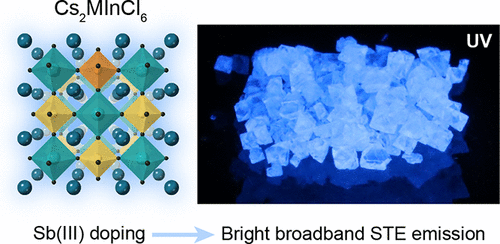当前位置:
X-MOL 学术
›
Chem. Mater.
›
论文详情
Our official English website, www.x-mol.net, welcomes your feedback! (Note: you will need to create a separate account there.)
Bright Blue and Green Luminescence of Sb(III) in Double Perovskite Cs2MInCl6 (M = Na, K) Matrices.
Chemistry of Materials ( IF 8.6 ) Pub Date : 2020-06-08 , DOI: 10.1021/acs.chemmater.0c01004 Agnieszka Noculak 1, 2 , Viktoriia Morad 1, 2 , Kyle M McCall 1, 2 , Sergii Yakunin 1, 2 , Yevhen Shynkarenko 1, 2 , Michael Wörle 1 , Maksym V Kovalenko 1, 2
Chemistry of Materials ( IF 8.6 ) Pub Date : 2020-06-08 , DOI: 10.1021/acs.chemmater.0c01004 Agnieszka Noculak 1, 2 , Viktoriia Morad 1, 2 , Kyle M McCall 1, 2 , Sergii Yakunin 1, 2 , Yevhen Shynkarenko 1, 2 , Michael Wörle 1 , Maksym V Kovalenko 1, 2
Affiliation

|
The vast structural and compositional space of metal halides has recently become a major research focus for designing inexpensive and versatile light sources; in particular, for applications in displays, solid-state lighting, lasing, etc. Compounds with isolated ns2-metal halide centers often exhibit bright broadband emission that stems from self-trapped excitons (STEs). The Sb(III) halides are attractive STE emitters due to their low toxicity and oxidative stability; however, coupling these features with an appropriately robust, fully inorganic material containing Sb3+ in an octahedral halide environment has proven to be a challenge. Here, we investigate Sb3+ as a dopant in a solution-grown metal halide double perovskite (DP) matrix, namely Cs2MInCl6:xSb (M = Na, K, x = 0–100%). Cs2KInCl6 is found to crystallize in the tetragonal DP phase, unlike Cs2NaInCl6 that adopts the traditional cubic DP structure. This structural difference results in distinct emission colors, as Cs2NaInCl6:xSb and Cs2KInCl6:xSb compounds exhibit broadband blue and green emissions, respectively, with photoluminescence quantum yields (PLQYs) of up to 93%. Spectroscopic and computational investigations confirm that this efficient emission originates from Sb(III)-hosted STEs. These fully inorganic DP compounds demonstrate that Sb(III) can be incorporated as a bright emissive center for stable lighting applications.
中文翻译:

双钙钛矿Cs2MInCl6(M = Na,K)基质中Sb(III)的亮蓝色和绿色发光。
金属卤化物的巨大结构和组成空间最近已成为设计廉价和通用光源的主要研究重点。具有隔离的ns 2-金属卤化物中心的化合物通常表现出明亮的宽带发射,该发射是由于自陷激子(STE)引起的,特别是用于显示器,固态照明,激光等。Sb(III)卤化物由于其低毒性和氧化稳定性而成为有吸引力的STE排放物。然而,在八面体卤化物环境中将这些特征与含有Sb 3+的适当坚固,完全无机的材料相结合已被证明是一个挑战。在这里,我们研究溶液生长的金属卤化物双钙钛矿(DP)基质,即Cs 2中作为掺杂剂的Sb 3+。MInCl 6:x Sb(M = Na,K,x = 0–100%)。发现Cs 2 KInCl 6在四方DP相中结晶,这与采用传统立方DP结构的Cs 2 NaInCl 6不同。这种结构差异导致发出不同的发射色,如Cs 2 NaInCl 6:x Sb和Cs 2 KInCl 6:x锑化合物分别表现出宽带蓝色和绿色发射,光致发光量子产率(PLQYs)高达93%。光谱和计算研究证实,这种有效排放源于Sb(III)承载的STE。这些完全无机的DP化合物表明,Sb(III)可以作为稳定的照明应用的明亮发射中心而被并入。
更新日期:2020-06-23
中文翻译:

双钙钛矿Cs2MInCl6(M = Na,K)基质中Sb(III)的亮蓝色和绿色发光。
金属卤化物的巨大结构和组成空间最近已成为设计廉价和通用光源的主要研究重点。具有隔离的ns 2-金属卤化物中心的化合物通常表现出明亮的宽带发射,该发射是由于自陷激子(STE)引起的,特别是用于显示器,固态照明,激光等。Sb(III)卤化物由于其低毒性和氧化稳定性而成为有吸引力的STE排放物。然而,在八面体卤化物环境中将这些特征与含有Sb 3+的适当坚固,完全无机的材料相结合已被证明是一个挑战。在这里,我们研究溶液生长的金属卤化物双钙钛矿(DP)基质,即Cs 2中作为掺杂剂的Sb 3+。MInCl 6:x Sb(M = Na,K,x = 0–100%)。发现Cs 2 KInCl 6在四方DP相中结晶,这与采用传统立方DP结构的Cs 2 NaInCl 6不同。这种结构差异导致发出不同的发射色,如Cs 2 NaInCl 6:x Sb和Cs 2 KInCl 6:x锑化合物分别表现出宽带蓝色和绿色发射,光致发光量子产率(PLQYs)高达93%。光谱和计算研究证实,这种有效排放源于Sb(III)承载的STE。这些完全无机的DP化合物表明,Sb(III)可以作为稳定的照明应用的明亮发射中心而被并入。



























 京公网安备 11010802027423号
京公网安备 11010802027423号